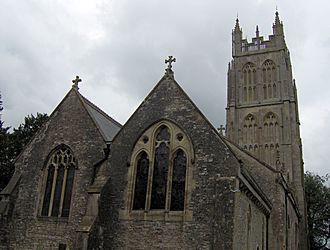Church of St Mary Magdalene, Chewton Mendip facts for kids
Quick facts for kids Church of St Mary Magdalene |
|
|---|---|
 |
|
| General information | |
| Town or city | Chewton Mendip |
| Country | England |
| Coordinates | 51°16′34″N 2°34′48″W / 51.2761°N 2.5799°W |
| Completed | 1440s |
The Church of St Mary Magdalene in Chewton Mendip, Somerset, England, is a very old and important church. It was mostly built in the 1540s and is a special Grade I listed building. This means it's a historic place that needs to be protected. The church is named after Mary Magdalene, a friend of Jesus.
Contents
History of the Church
The Church of St Mary Magdalene has a very long history. It began in Saxon times, with records going back to 560 AD. Over many centuries, new parts were added. Building work happened in the 12th, 13th, 14th, 15th, and 16th centuries.
The church you see today was started in 1441 by Carthusian monks. It still has some older Norman parts, like the north doorway. The tall tower was added later, around 1541.
Long ago, this church was a main church for the area. It had smaller chapels in nearby villages like Ston Easton and Paulton. After William the Conqueror took over England, he gave the church to a French abbey called Jumièges Abbey.
Later, an English king, Henry V, gave the church to the Priory of Sheen in Surrey. This lasted until the time of the Dissolution of the Monasteries. This was when many monasteries and churches were taken over by the King.
The church is still an active place of worship today. It is part of a group of churches that includes East Harptree and West Harptree.
Church Design and Features
The Church of St Mary Magdalene is built from local stone. The main part is made of Lias Stone. Its impressive tower, which is about 126 feet (38 meters) tall, is made from Doulting Stone. This tower was still being finished in 1541.
The tower has a bell from 1753, made by Thomas Bilbie. There are also eight other bells made by Taylor's of Loughborough.
Inside the church, you can find some interesting old features. Near the altar, there is a special stone seat. This seat is called a 'frid stool'. In medieval times, people, especially criminals, could sit here to claim sanctuary. This meant they were safe from arrest while inside the church.
Inside the Church
The church has monuments to important people from the past. These include Sir Henry Fitzroger and his wife, who passed away in 1388. There is also a monument to Frances, Lady Waldegrave, from 1879. The Waldegrave family has owned land in Chewton since 1553.
Most of the stained glass windows you see today were made in the 1800s. However, some small pieces of glass from the 1400s or even earlier are still in the chancel window. Some of these old glass pieces were found in a ditch near Glastonbury and later put into the church's windows.
You can also see three piscinae, which are stone basins used for washing sacred vessels. There are two old medieval chests and carved wooden bench ends from the 1500s. The round font, used for baptisms, is very old and stands under the tower.
Churchyard Cross
In the churchyard, there is a stone cross from the 1400s. This cross is also a Grade I listed building, just like the church itself. It is an important historical monument.
See also
- List of ecclesiastical parishes in the Diocese of Bath and Wells


